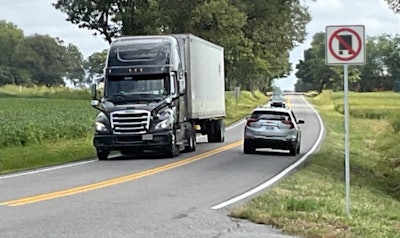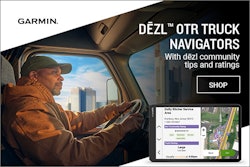
Kentucky wants to keep large commercial vehicles from using its rural roads for shortcuts.
The Kentucky Transportation Cabinet (KYTC) and Kentucky State Police Division of Commercial Vehicle Enforcement are reminding long-haul truck drivers to stay on routes that have been established as appropriate for the weight and size of their vehicles.
KYTC District 1 in Paducah and Kentucky State Police Post 1 in Mayfield have increased efforts to deter tractor-trailers from attempting shortcuts on rural secondary roads that were not designed for large cross-country trucks. They say this is a common problem across the commonwealth and neighboring states.
“This is a recurring issue as drivers try to save on time and fuel,” District 1 Chief District Engineer Kyle Poat said. “But our rural secondary roads were not built for regular through-travel by vehicles of such size and weight.”
In a recent statement, the transportation cabinet and state police said the conflict is playing out on roads across the commonwealth such as KY Hwy 286, which crosses southern Ballard County and forms a cut-through between Wickliffe and Paducah. They said over the last three years, there have been 119 crashes, 40 injury crashes and five fatalities along just over 16 miles of KY 286.
About 30 of the crashes involved a semi or “STAA truck,” a reference to the Surface Transportation Assistance Act of 1982. The law established and defined a national truck network of highways and bridges suitable for large trucks. Of the 24 most recent crashes on KY 286, about half involved commercial trucks.
“No Truck" signs have been installed at each end of KY 286 and at state highway intersections. Commercial Vehicle Enforcement officers have also stepped up patrols and written numerous citations.
When the cases came before the district court, the judge expressed his opinion about the need for signage indicating no trucks. CVE Officer Mark Townsend asked KYTC District 1 for help and “No Truck” signs were installed, according to the two agencies.
“The signs will help with enforcement efforts as additional cases come up in district court,” Townsend said. “The legal responsibility falls on the CDL-carrying professional driver. The driver is required to follow a route that keeps the truck on the National Truck Network.”
To avoid the restricted section of KY 286, cross-country truckers traveling between Wickliffe and Paducah should follow U.S. 60. The “No Truck” signs and restrictions do not apply to local farmers or trucks making local deliveries along KY 286.
The widespread use of cell phone GPS mapping apps created for passenger vehicles also contributes to trucks ending up on inappropriate routes, according to the statement. The phone apps lack features that mark low overpasses, and denote narrow roadways and other obstacles trucks should avoid.
For example, Poat said long-haul truck drivers following passenger vehicle phone apps are sometimes routed onto the U.S. 45 Ohio River “Brookport” Bridge, which has weight, height and vehicle width restrictions that prohibit commercial trucks.
Truckers following cell phone mapping systems often hit a low railroad overpass in Hickman County along KY 307 north of KY 94, despite numerous warning signs. The problem becomes more acute when truckers follow phone apps while attempting to detour around crashes that block major routes.
Poat says truckers could prevent trouble for themselves and other highway users by purchasing a GPS unit or map app specifically programmed to direct over-the-road trucks to the National Truck Network.
KYTC is asking several websites that cater to long-haul truckers to help alert commercial drivers to the hazards of navigating with phone map apps that are not designed for SEMI trucks. The agency also offered a list of mapping systems and apps that are specifically designed for commercial trucks. That list includes:
- Trucker Tools (FREE): https://www.truckertools.com/carriers/trucker-tools-app/Smart Truck Route (FREE): https://www.smarttruckroute.com/ Trucker Path: https://truckerpath.com/
- MileOn: https://mileonapp.com/
- Truckmap: https://truckmap.com/
- TomTom GO Navigation (available truck-specific subscription). https://www.tomtom.com/en_us/navigation/mobile-apps/go-navigation-app/
- Hammer App: https://www.hammerapp.com/










